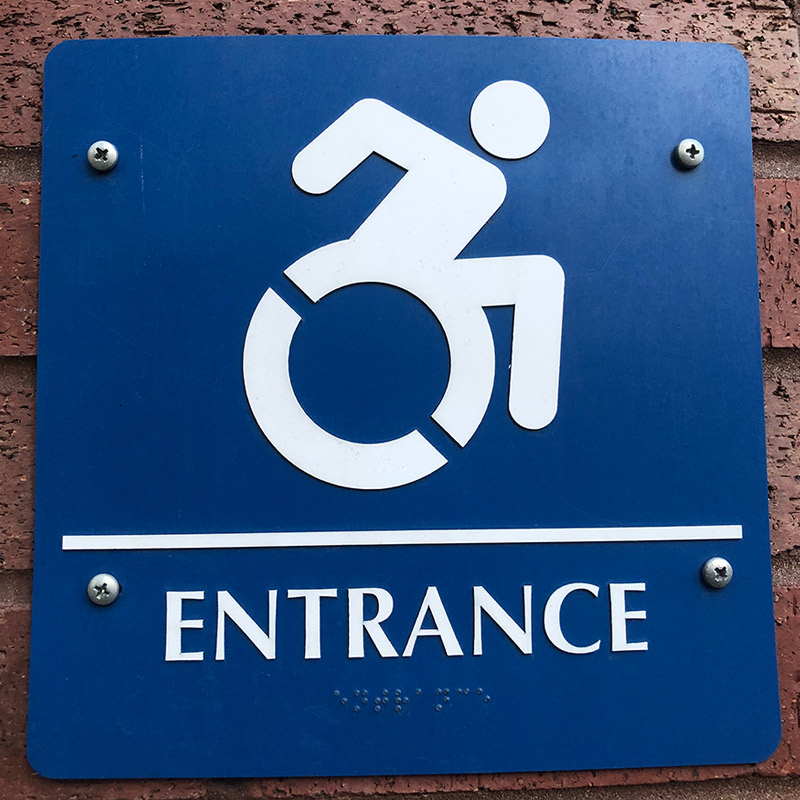Just How ADA Signs Boost Accessibility for Everyone
Just How ADA Signs Boost Accessibility for Everyone
Blog Article
Checking Out the Key Features of ADA Signs for Boosted Access
In the world of ease of access, ADA indicators serve as silent yet effective allies, guaranteeing that rooms are navigable and inclusive for individuals with handicaps. By integrating Braille and responsive components, these signs damage obstacles for the visually impaired, while high-contrast shade systems and clear typefaces cater to varied visual needs.
Significance of ADA Compliance
Making sure compliance with the Americans with Disabilities Act (ADA) is essential for cultivating inclusivity and equivalent access in public areas and offices. The ADA, enacted in 1990, mandates that all public facilities, employers, and transport solutions suit individuals with impairments, ensuring they enjoy the exact same civil liberties and possibilities as others. Compliance with ADA standards not only satisfies lawful commitments yet additionally enhances an organization's credibility by demonstrating its commitment to diversity and inclusivity.
One of the essential facets of ADA compliance is the execution of available signs. ADA indicators are developed to guarantee that individuals with specials needs can conveniently browse through buildings and spaces.
Additionally, adhering to ADA regulations can reduce the danger of legal effects and prospective penalties. Organizations that stop working to adhere to ADA standards may face legal actions or charges, which can be both harmful and financially difficult to their public picture. Thus, ADA conformity is indispensable to promoting a fair setting for every person.
Braille and Tactile Elements
The unification of Braille and responsive elements right into ADA signs symbolizes the concepts of accessibility and inclusivity. It is generally positioned under the corresponding text on signage to make certain that individuals can access the information without visual help.
Responsive elements extend beyond Braille and consist of elevated signs and characters. These components are designed to be noticeable by touch, permitting people to determine room numbers, washrooms, exits, and various other critical locations. The ADA establishes details guidelines concerning the size, spacing, and positioning of these responsive elements to optimize readability and make certain uniformity across various settings.
High-Contrast Color Pattern
High-contrast color design play a critical duty in improving the visibility and readability of ADA signs for individuals with aesthetic disabilities. These schemes are crucial as they make best use of the difference in light reflectance in between text and history, making sure that signs are quickly discernible, also from a distance. The Americans with Disabilities Act (ADA) mandates using certain shade contrasts to accommodate those with restricted vision, making it a crucial facet of conformity.
The effectiveness of high-contrast shades hinges visit their website on their capacity to attract attention in different lighting conditions, consisting of dimly lit atmospheres and locations with glow. Generally, dark message on a light background or light message on a dark history is employed to accomplish optimum contrast. For instance, black message on a white or yellow background supplies a raw visual difference that assists in fast recognition and comprehension.

Legible Fonts and Text Dimension
When considering the design of ADA signage, the option of readable typefaces and appropriate text size can not be overstated. These elements are important for making certain that indicators come to people with visual problems. The Americans with Disabilities Act (ADA) mandates that typefaces need to be not italic and sans-serif, oblique, script, extremely ornamental, or of uncommon type. These demands assist make sure that the message is quickly understandable from a distance and that the characters are distinguishable to diverse target markets.
According to ADA guidelines, the minimal text elevation must be 5/8 inch, and it should raise proportionally with seeing range. Consistency in message size adds to a cohesive aesthetic experience, aiding people in navigating settings efficiently.
In addition, spacing between lines and letters is essential to readability. Sufficient spacing protects against characters from showing up crowded, improving readability. By sticking to these standards, developers can considerably enhance access, guaranteeing that signage serves its designated function for all individuals, regardless of their aesthetic abilities.
Reliable Placement Methods
Strategic positioning of ADA signage is necessary for optimizing accessibility and making sure conformity with lawful criteria. Appropriately located signs direct people with handicaps effectively, helping with navigating in public rooms. Trick considerations include exposure, distance, and elevation. ADA standards specify that indicators need to be placed at a height in between 48 to 60 inches from the ground to ensure they are within the line of sight for both standing sites and seated individuals. This basic height variety is important for inclusivity, making it possible for mobility device users and individuals of differing elevations to accessibility details easily.
Furthermore, indications should be positioned nearby to the lock side of doors to enable easy recognition before access. Consistency in indicator placement throughout a center enhances predictability, lowering confusion and boosting overall customer experience.

Verdict
ADA indications play a crucial role in promoting availability by integrating functions that attend to the demands of people with impairments. Incorporating Braille and tactile components ensures essential information comes to the visually damaged, while high-contrast color design and readable sans-serif typefaces improve presence throughout various lights conditions. Effective placement methods, such as ideal placing heights and tactical places, additionally promote navigating. These elements collectively foster an inclusive environment, highlighting the significance of ADA conformity in guaranteeing equal gain access to for all.
In the world of access, ADA indicators serve as silent yet powerful allies, guaranteeing that spaces are inclusive and navigable for people with impairments. The ADA, enacted in 1990, mandates that all public centers, employers, and transportation solutions suit individuals with impairments, ensuring they appreciate the very same rights and possibilities as others. ADA Signs. ADA indications are developed to guarantee that people with specials needs can conveniently browse with buildings and rooms. ADA standards specify that indications should be placed at an elevation between 48 to 60 inches from the ground to guarantee they are within the line of sight for both standing and seated individuals.ADA indicators play a crucial role in advertising ease of access by integrating features that attend to the needs of people site here with impairments
Report this page